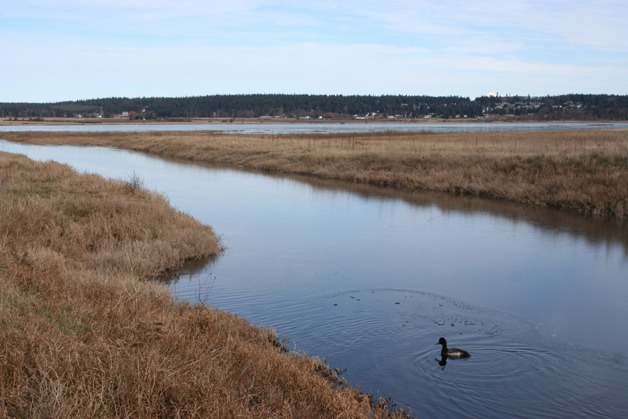The Whidbey Camano Land Trust will continue to accept Navy money to acquire land within Ebey’s Reserve, despite a request from jet noise opponents to sever the relationship.
Citizens of Ebey’s Reserve, or COER, asked last month that the Land Trust cease using Navy funds until the ongoing Environmental Impact Statement on the EA-18G Growler is concluded. That’s expected to take about 17 months.
COER has criticized the noise levels of the Navy’s touch-and-go operations at Outlying Field Coupeville, which is surrounded by residential homes and shares a property line with Ebey’s Landing National Historical Reserve.
COER offered to give a presentation in January to the land trust board about the proposed moratorium on Navy funding, but were denied.
“The board appreciates COER’s offer of an in-person presentation, but found it to be unnecessary,” wrote president Lenny Corin last month in a letter to COER member Maryon Attwood.
The board voted unanimously to “continue to use Navy funds to accomplish its mission” protecting the island’s natural resources.
Corin goes on to state that the nonprofit organization “does not engage in political, partisan or regulatory matters.”
Pat Powell, executive director of the Whidbey Camano Land Trust, said that the Navy’s involvement in land trust acquisitions is very small and that the board is unclear why COER made its request.
“They made a very big issue out of a very small matter,” Powell said. “We don’t understand why they tried to involve us in their issue.”
Of the 65 projects completed by the land trust since 2003, which involved 7,230 acres throughout Island County, only 247 acres or 3 percent included Navy funding.
COER President Michael Monson said that his group pressed this issue on principle.
“If anyone, they should be the ones taking a side … or doing a little something,” Monson said.
Monson said the trust board’s partnership with the Navy is “complicit” in its aim to acquire land around OLF instead of pursuing a new location.
While the trust board’s primary purpose is about preserving land, Monson said, their mission also dovetails with the Navy’s desire to limit development around the airfield.
The trust board sent COER a two-page document supporting their decision to not “take sides” on the issue, and outlining their mission.
“The land trust has, since its inception, consistently turned down requests to ‘take sides’ on a number of highly controversial issues that are not directly related to its mission.”
COER responded with their own document, saying that they were “surprised” that the board considered the moratorium “taking sides,” and that they are “saddened that the land trust has missed the ‘Forest for the trees.’”
“We were denied the opportunity to make our case,” COER responded, in a letter to the trust board. “If the people of Central Whidbey were an old growth forest, or endangered plants or animals, or a single tract of 100 acres of farmland, we would be treated with more compassionate respect.”
“The Navy’s decision to place the EA-18G Growler on Whidbey Island, when they have other choices, has divided our community in many disturbing ways. Your decision not to extend a brief moratorium is yet one more proof of this.”
The Navy has maintained the base is “ideally located for training operations due to the low density of civilian aircraft traffic in the Continental United States” and that OLF is “the most realistic and efficient environment” in which to perform touch-and-go training, according to Mike Welding, public affairs officer for the base.



